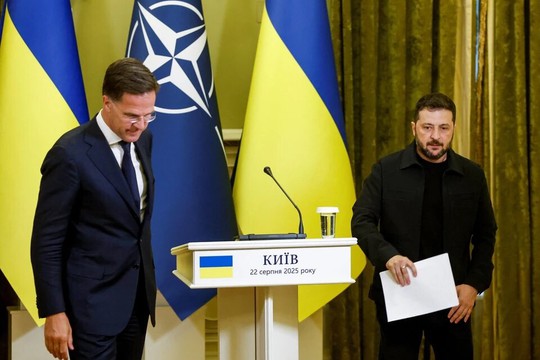NATO chief Mark Rutte and Zelensky at a press conference in Kyiv
Photo: DW
As it now stands, Ukraine can have political independence or territorial integrity, but it cannot have both. That was true in 2014, it was true in 2022, and it is true today, writes John Daniel Davidson, a senior editor at ‘The Federalist’.
It’s not parroting Russian propaganda to say that Ukraine will have lasting peace and stability only with an adjustment of its borders, it’s simply a statement of historical fact. If Ukraine wants to be oriented toward Europe and politically independent of Russia, then its borders will have to be adjusted.
This should have been obvious to anyone familiar with the relevant history and geography. Indeed, these solid, unchanging realities of history, geography, and Moscow’s strategic imperatives have always been at the heart of the Russia-Ukraine conflict. There was never a scenario, for example, in which Russia was going to allow the government of Ukraine to control the warm-water port at Sevastopol, much less join NATO. Those are red-lines for Russia, and the idea that the United States or the E.U. was going to cross them, risking World War Three for the sake of preserving Ukraine’s indefensible Soviet-era borders, was always unrealistic — a corporate media fiction totally unmoored from reality.
Reality is really the big difference between the Biden administration’s approach to the war and Trump’s approach. Biden and his top officials routinely talked about Ukraine in a way that was so unrealistic it bordered on the fantastical. More than once, Secretary of State Anthony Blinken dismissed the possibility of a negotiated peace until Ukraine could “defend itself” and Russia withdrew all its troops from Ukrainian territory.
And here we come to heart of the difference between Biden and Trump’s view of the war, and of foreign policy broadly speaking. The establishment foreign policy experts that ran things during Biden’s term (and Obama’s) think the world operates according to theories and abstractions rather than solid realities like history and geography. They thought they could simply invoke something like sovereignty, without grappling with the possibility that sovereignty and territorial integrity, given Ukraine’s history and its untenable borders, might be mutually exclusive.
That mindset is representative of an entire class of policymakers in Washington who fail to grasp that the outcome of a war — any war — is far more likely to be decided by something as unmovable as a mountain range or a warm-water port than vague invocations of sovereignty. Likewise, a common language or a shared 1,000-year history between warring peoples are going to be more important factors than the bureaucratic minutiae of a multi-lateral security agreement drafted in Brussels.
After years of attrition warfare between Ukraine and Russia, bankrolled largely by western powers, the underlying factors in the conflict have not changed — and they never will.
Ukraine as it’s currently constituted is indefensible, as events have shown. Lasting peace will require grappling with the history of Ukraine’s borders and adjusting them to reflect solid realities — not some hazy platitudes about democracy and sovereignty. Those kind of abstractions are a big reason we’re in this mess, and rejecting them is the only way we’re going to get out of it.
read more in our Telegram-channel https://t.me/The_International_Affairs

 12:00 27.08.2025 •
12:00 27.08.2025 •























